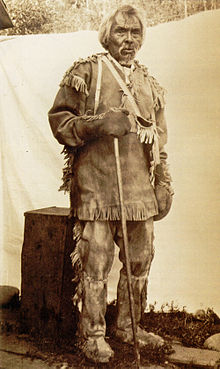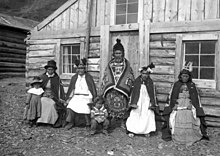


James Teit, Tahltan medical practitioner, c. 1932
| |
| Regions with significant populations | |
|---|---|
| Canada (British Columbia) | |
| Languages | |
| English, Tahltan | |
| Religion | |
| Christianity, Animism | |
| Related ethnic groups | |
| Kaska, Tagish |

The TahltanorNahani are a First Nations people of the Athabaskan-speaking ethnolinguistic group who live in northern British Columbia around Telegraph Creek, Dease Lake, and Iskut. The Tahltan constitute the fourth division of the Nahane (People of the West).[1]

The Tahltan cultural practices and lifeways varied widely as they were often widely separated and would have to endure varying conditions depending on their locality.[2] In Tahltan culture it was believed that some of their ancestors had knowledge that others did not from times before a great flood.[3]: 232 Some of these ancestors used that knowledge for the good of the people, while others used it for evil and to the disadvantage of others. Raven is considered to be the protagonist hero against these evil ancestors.[4]
Tahltan social organization is founded on matriarchy and intermarriage between two main clan designations. The two main clans of Tahltan people are Tses' Kiya (pronounced Tses-kee-ya) (Crow) and Chiyone (pronounced Chee-oanah) (Wolf). These two clans are further subdivided into four parties:[5]
Contemporary Tahltan society constitutes itself as the Tahltan Nation, which comprises the membership and governments of the Tahltan First Nation and Iskut First Nation.

Ten thousand years ago, the Tahltan people used obsidian from Mount Edziza to make tools and weapons for trading material. This is the main source of obsidian found in northwestern British Columbia.[6][7]
Coal-bed methane extraction had already been the subject of protests in the Bulkley Valley against a project planned near Telkwa, British Columbia. In a unanimous 2003 resolution, the Union of B.C. Municipalities asked for a moratorium on coal-bed methane mining in the province.[8]
Since 2005, the Klabona Keepers, a group of Tahltan elders, have watched the road leading through Tahltan territory towards the Sacred headwaters (Klappan Valley) in opposition to development there, specifically a coalbed methane mining project planned by Royal Dutch Shell.[8] The Sacred Headwaters (Klappan Valley) is home to the headwaters of the Nass, Skeena and Stikine Rivers. Not only do these rivers provide a home to important salmon stocks, Tahltan oral history holds that these headwaters are the place where the earth was first created and where Talhtan culture began.[8] According to the Klabona Keepers, the valley is used for fishing, hunting, and trapping. It is the site of a Tahltan burial ground and a cultural camp where Talhtan youth can learn their culture in the summer.
In 2004, Shell was awarded the oil and gas rights to the Klappan Valley, one of British Columbia's largest coal deposits with an estimated 230 km3 (8 trillion cu ft) of methane.[8] That year, Shell drilled three exploratory wells at the headwaters, but in 2005 four Shell employees who arrived at the band office in Iskut were turned away by a group of elders and no drilling occurred that summer. Non-violent blockades in 2005 and 2006 delayed development efforts and led to the arrests of 13 protesters. Talhtan territory was the site of half of all the mining exploration in British Columbia during 2006.[8] Protests in Smithers have been as large as 600 people. David Suzuki and Wade Davis have both criticized plans for coal-bed methane mining in the headwaters and, in June 2007, 14 different environmental groups sent a joint letter to Shell opposing the project.[8]
Representatives from Shell assert a determination to reach consensus in the community and note that the elected Tahltan Central Council (TCC) agreed to the exploration.[8] Chief Jerry Asp was forced to resign in 2005 after protests from Tahltan members accusing him of a conflict of interest because of his involvement with two pro-development organizations.[8]
On December 18, 2012, the B.C. government announced that Shell would be withdrawing its plans to explore and drill for coalbed methane gas in the Tahltan Territory.[9] According to the Skeena Watershed Conservation Coalition, Shell has launched a lawsuit against Talhtan elders for loss of revenue.[8] The Klabona Keepers have filed a counter-suit for failure to consult. Employment opportunities have come from natural resources development in recent years. Because of various concerns over the lands, the parties involved balance development and environmental aspects.
Talk of an Alaska-Canada railroad traversing Tahltan lands recurs every so often with feasibility studies being done.[10]
Tahltan is a poorly documented Northern Athabaskan language. Some linguists consider Tahltan to be a language with three divergent but mutually intelligible dialects.[11] Other linguists consider these to be separate languages. The number of speakers are below.
{{cite book}}: |last1= has generic name (help)
| Authority control databases: National |
|
|---|